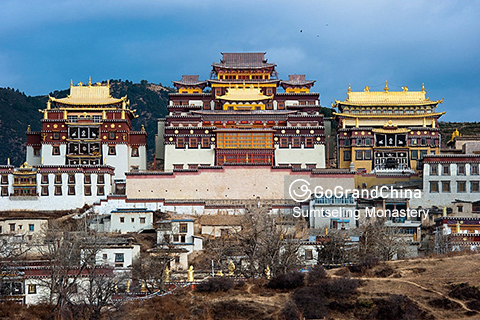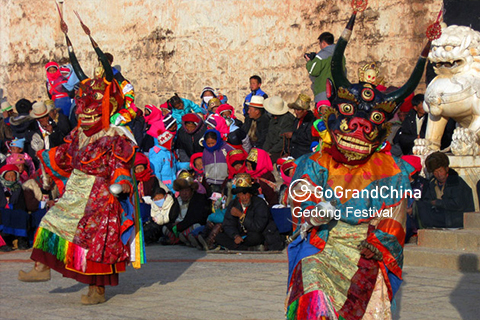Sumtseling Monastery
Introducing Sumtseling Monastery (from Wikipedia)
The Ganden Sumtsenling Monastery is the largest Tibetan Buddhist monastery in Yunnan province and is sometimes referred to as the Little Potala Palace. Located in the capital of Diqing Tibetan Autonomous Prefecture, it is also the most important monastery in southwest China. The Sumtseling monastery belonging to the Gelukpa order of Buddhism was established by the Fifth Dalai Lama in 1679. It was built during the rule of the Qing dynasty Kangxi Emperor (r.1662-1722). He fully patronized the development of this monastery. Its architecture is a fusion of the Tibetan and Han Chinese. At its peak, the monastery contained accommodation for 2,000 monks; it currently accommodates in its rebuilt structures 700 monks in 200 associated houses.
Sumtseling Monastery Fast Facts
• Chinese Name: Song Zan Lin Si 松赞林寺
• Best Time to Visit: June, July, September & October
• Recommended Visiting Hours: 2 - 3 hours
• Things to Do: Photography, Buddhism, Architecture
• Opening Hours: 08:00-18:00
• Entrance Fee: CNY 115
• Address: Jiantang Town, Shangri-La, Diqing Tibetan Autonomous Prefecture, Yunnan
What to expect at Sumtseling Monastery
Structures
The Monastery built in the 17th century as the largest Buddhist monastery in Yunnan province, after a revelation by the Fifth Dalai Lama is in accordance with Tibetan traditional architectural style. It has six main structures including eight colleges. The entrance gate is at the foot of the hill and provides access to the main hall of the monastery through 146 steps.
In the main hall of the monastery, more than 1500 monks congregate to recite the Buddhist scriptures. This hall houses a plethora of scriptures written on palm leaves, a gilded statue of Shakyamuni Buddha which is 8 metres (26 ft) tall at the main altar along with paintings depicting the life of Buddha. The altar has permanent decorated by yak butter lamps.
The monastery has two major lamasery buildings – Zhacang and Jikang – apart from several smaller lamaseries. Numerous living rooms have also been built for the monks to reside. The main monastery structure built in Tibetan style has a gilded copper roof similar to the one at the Potala Monastery in Lhasa. The other buildings in the complex are built in Han Chinese style.
The road from the old town of the city, leads to the scripture chamber (Gucheng Zangjingtang), which was earlier a Red Army Memorial hall to commemorate the Red Army's long march in the 1930s. At the opposite end of this hall, across the street is the Gulshan Park (Gulshan Gongyuan), which has a monastery with a commanding view of the town and its surroundings. Further along the road, known as the 'Changzeng Lu' (2 kilometres (1.2 mi) long north-south trending street with intersecting roads laid in grid pattern) to the extreme south, is another temple. Passing through this street leads to gardens and a pavilion; and further to the north on a hill, there is a Chorten (Tibetan stupa). The east west road 'Tuanje Jie' leads to many smaller temples at the south end around the old town.


Gedong Festival
The Gedong Festival is held in the precincts of the monastery annually on 26 to 29 November (Tibetan Calendar) when devotees from the region attend to worship and also to witness the religious mask dances – the Cham dance – that are performed by the monks in colourful costumes depicting deities, ghosts and animals.
How to get to Sumtseling Monastery
• Take bus 3 or 16 to Sumtseling Monastery.
• Rent a car/bus from GGC to enjoy a hassle free private transfer from hotels in Shangri-La to Sumtseling Monastery.
Additional travel advice on Sumtseling Monastery
• With an average elevation over 3,300 meters, a mild altitude sickness in Shangri-La is quite common. Avoid strenuous activity, and better drink more water. Prepare AMS medication, in accordance with a doctor's advice.
• Sunglasses and sun cream are always needed to protect from the sunburn and strong ultraviolet radiation in the daytime.
• Sumtseling Monastery is a religious site, so visitors should dress modestly, behave with good manner. Do not wear hat or sunglasses in halls of the temple.
• In the principle of Tibetan Buddhist culture, walking around temples, palaces and turning praying wheels should follow the clockwise direction.
There are no products matching the selection.
